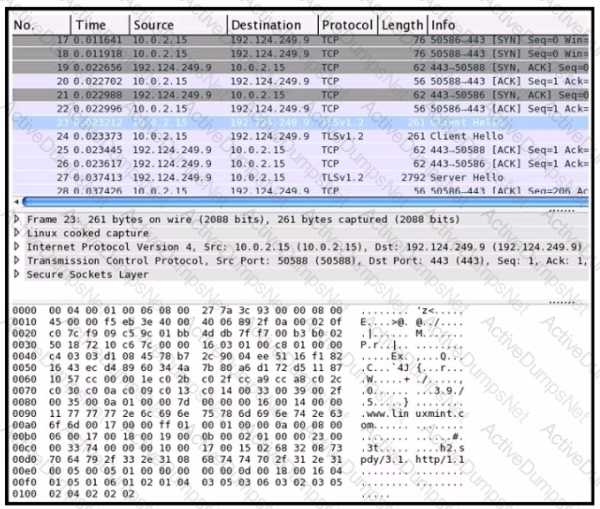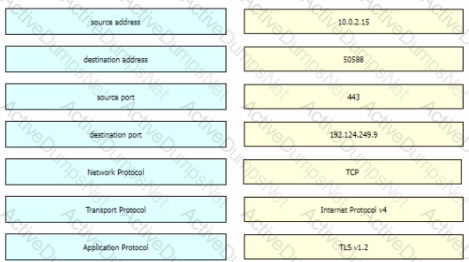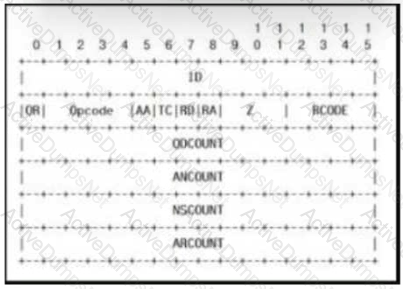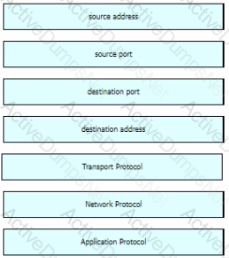Cisco 200-201 Understanding Cisco Cybersecurity Operations Fundamentals (CBROPS) Exam Practice Test
Understanding Cisco Cybersecurity Operations Fundamentals (CBROPS) Questions and Answers
Refer to the exhibit.
During the analysis of a suspicious scanning activity incident, an analyst discovered multiple local TCP connection events Which technology provided these logs?
Refer to the exhibit.
What is occurring in this network traffic?
What describes a buffer overflow attack?
Which evasion technique is a function of ransomware?
Which element is included in an incident response plan as stated m NIST SP800-617
Which system monitors local system operation and local network access for violations of a security policy?
What is the impact of false positive alerts on business compared to true positive?
What is obtained using NetFlow?
An investigator is examining a copy of an ISO file that is stored in CDFS format. What type of evidence is this file?
Which two elements are used for profiling a network? (Choose two.)
Which type of data must an engineer capture to analyze payload and header information?
Which type of data consists of connection level, application-specific records generated from network traffic?
What is a sandbox interprocess communication service?
Refer to the exhibit.
An analyst was given a PCAP file, which is associated with a recent intrusion event in the company FTP server Which display filters should the analyst use to filter the FTP traffic?
What is the difference between the ACK flag and the RST flag?
Which open-sourced packet capture tool uses Linux and Mac OS X operating systems?
What is the practice of giving an employee access to only the resources needed to accomplish their job?
A security specialist notices 100 HTTP GET and POST requests for multiple pages on the web servers. The agent in the requests contains PHP code that, if executed, creates and writes to a new PHP file on the webserver. Which event category is described?
Which attack method intercepts traffic on a switched network?
Refer to the exhibit.
An engineer is analyzing this Cuckoo Sandbox report for a PDF file that has been downloaded from an email. What is the state of this file?
A security incident occurred with the potential of impacting business services. Who performs the attack?
Refer to the exhibit. An employee received an email from an unknown sender with an attachment and reported it as a phishing attempt. An engineer uploaded the file to Cuckoo for further analysis. What should an engineer interpret from the provided Cuckoo report?
What does an attacker use to determine which network ports are listening on a potential target device?
Why should an engineer use a full packet capture to investigate a security breach?
Refer to the exhibit.
A security analyst is investigating unusual activity from an unknown IP address Which type of evidence is this file1?
What is rule-based detection when compared to statistical detection?
A security engineer must protect the company from known issues that trigger adware. Recently new incident has been raised that could harm the system. Which security concepts are present in this scenario?
Refer to the exhibit.
An engineer received a ticket about a slowed-down web application. The engineer runs the #netstat -an command. How must the engineer interpret the results?
What is an advantage of symmetric over asymmetric encryption?
The SOC team has confirmed a potential indicator of compromise on an endpoint. The team has narrowed the executable file's type to a new trojan family. According to the NIST Computer Security Incident Handling Guide, what is the next step in handling this event?
According to CVSS, what is a description of the attack vector score?
An analyst is exploring the functionality of different operating systems.
What is a feature of Windows Management Instrumentation that must be considered when deciding on an operating system?
Refer to the exhibit. An attacker scanned the server using Nmap. What did the attacker obtain from this scan?
During which phase of the forensic process are tools and techniques used to extract information from the collected data?
Refer to the exhibit.

Which two elements in the table are parts of the 5-tuple? (Choose two.)
How low does rule-based detection differ from behavioral detection?

Refer to the exhibit Drag and drop the element names from the left onto the corresponding pieces of the PCAP file on the right.

An engineer is addressing a connectivity issue between two servers where the remote server is unable to establish a successful session. Initial checks show that the remote server is not receiving an SYN-ACK while establishing a session by sending the first SYN. What is causing this issue?
What is the difference between inline traffic interrogation (TAPS) and traffic mirroring (SPAN)?
An engineer is working with the compliance teams to identify the data passing through the network. During analysis, the engineer informs the compliance team that external penmeter data flows contain records, writings, and artwork Internal segregated network flows contain the customer choices by gender, addresses, and product preferences by age. The engineer must identify protected data. Which two types of data must be identified'? (Choose two.)
Refer to the exhibit.

What is the outcome of the command?
Drag and drop the uses on the left onto the type of security system on the right.
An analyst received a ticket regarding a degraded processing capability for one of the HR department's servers. On the same day, an engineer noticed a disabled antivirus software and was not able to determine when or why it occurred. According to the NIST Incident Handling Guide, what is the next phase of this investigation?
Which type of data collection requires the largest amount of storage space?
Refer to the exhibit.
What information is depicted?
Which tool provides a full packet capture from network traffic?
What is the communication channel established from a compromised machine back to the attacker?
According to the September 2020 threat intelligence feeds a new malware called Egregor was introduced and used in many attacks. Distnbution of Egregor is pnmanly through a Cobalt Strike that has been installed on victim's workstations using RDP exploits Malware exfiltrates the victim's data to a command and control server. The data is used to force victims pay or lose it by publicly releasing it. Which type of attack is described?
An engineer needs to have visibility on TCP bandwidth usage, response time, and latency, combined with deep packet inspection to identify unknown software by its network traffic flow. Which two features of Cisco Application Visibility and Control should the engineer use to accomplish this goal? (Choose two.)
What is personally identifiable information that must be safeguarded from unauthorized access?
Refer to the exhibit.

This request was sent to a web application server driven by a database. Which type of web server attack is represented?
Refer to the exhibit.
A workstation downloads a malicious docx file from the Internet and a copy is sent to FTDv. The FTDv sends the file hash to FMC and the tile event is recorded what would have occurred with stronger data visibility.
What causes events on a Windows system to show Event Code 4625 in the log messages?
Which evasion technique is indicated when an intrusion detection system begins receiving an abnormally high volume of scanning from numerous sources?
An engineer configured regular expression “.”\.(pd][Oo][Cc)|[Xx][LI][Ss]|[Pp][Pp][Tt]) HTTP/1 .[01]" on Cisco ASA firewall. What does this regular expression do?
What is a difference between SOAR and SIEM?
Refer to the exhibit.

Which field contains DNS header information if the payload is a query or a response?
What ate two categories of DDoS attacks? (Choose two.)
What is the difference between mandatory access control (MAC) and discretionary access control (DAC)?
Refer to the exhibit.
An attacker scanned the server using Nmap.
What did the attacker obtain from this scan?
A company is using several network applications that require high availability and responsiveness, such that milliseconds of latency on network traffic is not acceptable. An engineer needs to analyze the network and identify ways to improve traffic movement to minimize delays. Which information must the engineer obtain for this analysis?
What is an example of social engineering attacks?
An analyst is exploring the functionality of different operating systems.
What is a feature of Windows Management Instrumentation that must be considered when deciding on an operating system?
Drag and drop the security concept on the left onto the example of that concept on the right.

Which security model assumes an attacker within and outside of the network and enforces strict verification before connecting to any system or resource within the organization?
What is a difference between tampered and untampered disk images?
While viewing packet capture data, an analyst sees that one IP is sending and receiving traffic for multiple devices by modifying the IP header.
Which technology makes this behavior possible?
An engineer received an alert affecting the degraded performance of a critical server Analysis showed a heavy CPU and memory load What is the next step the engineer should take to investigate this resource usage7
Drag and drop the security concept from the left onto the example of that concept on the right.
How does a certificate authority impact security?
Which two components reduce the attack surface on an endpoint? (Choose two.)
Drag and drop the type of evidence from the left onto the description of that evidence on the right.
An engineer is investigating a case of the unauthorized usage of the “Tcpdump” tool. The analysis revealed that a malicious insider attempted to sniff traffic on a specific interface. What type of information did the malicious insider attempt to obtain?
What is a benefit of agent-based protection when compared to agentless protection?
Which action prevents buffer overflow attacks?
How does an attacker observe network traffic exchanged between two users?
What is the difference between the ACK flag and the RST flag in the NetFlow log session?
How can TOR impact data visibility inside an organization?
Which data type is necessary to get information about source/destination ports?
Which option describes indicators of attack?
What describes the defense-m-depth principle?
Refer to the exhibit.
An attacker gained initial access to the company s network and ran an Nmap scan to advance with the lateral movement technique and to search the sensitive data Which two elements can an attacker identify from the scan? (Choose two.)
Which type of attack occurs when an attacker is successful in eavesdropping on a conversation between two IP phones?
Endpoint logs indicate that a machine has obtained an unusual gateway address and unusual DNS servers via DHCP Which type of attack is occurring?
Which type of verification consists of using tools to compute the message digest of the original and copied data, then comparing the similarity of the digests?
A user received a malicious attachment but did not run it. Which category classifies the intrusion?
What is the difference between indicator of attack (loA) and indicators of compromise (loC)?
Which step in the incident response process researches an attacking host through logs in a SIEM?
What is data encapsulation?
Which principle is being followed when an analyst gathers information relevant to a security incident to determine the appropriate course of action?
A network engineer noticed in the NetFlow report that internal hosts are sending many DNS requests to external DNS servers A SOC analyst checked the endpoints and discovered that they are infected and became part of the botnet Endpoints are sending multiple DNS requests but with spoofed IP addresses of valid external sources What kind of attack are infected endpoints involved in1?
How does agentless monitoring differ from agent-based monitoring?
Which security technology guarantees the integrity and authenticity of all messages transferred to and from a web application?
Refer to the exhibit.
What does the message indicate?
Refer to the exhibit.
Which stakeholders must be involved when a company workstation is compromised?
Which type of attack uses a botnet to reflect requests off of an NTP server to overwhelm a target?
What specific type of analysis is assigning values to the scenario to see expected outcomes?
Which two elements of the incident response process are stated in NIST Special Publication 800-61 r2? (Choose two.)
When trying to evade IDS/IPS devices, which mechanism allows the user to make the data incomprehensible without a specific key, certificate, or password?


 A screenshot of a computer
Description automatically generated
A screenshot of a computer
Description automatically generated